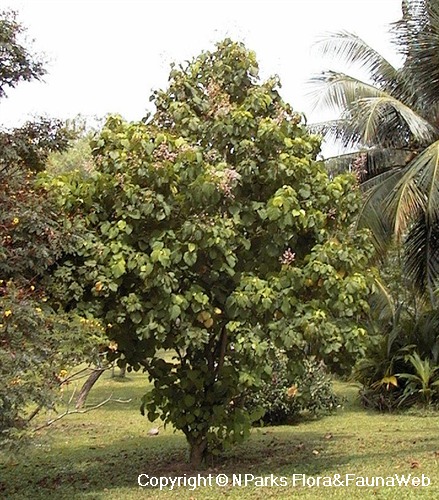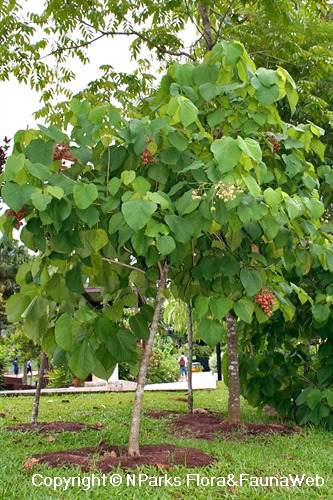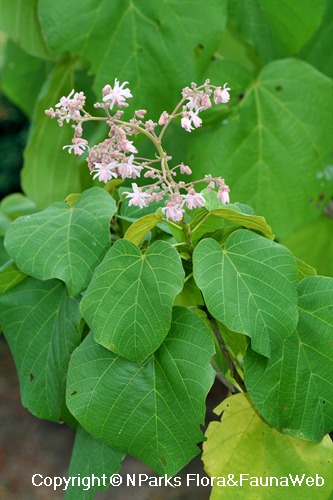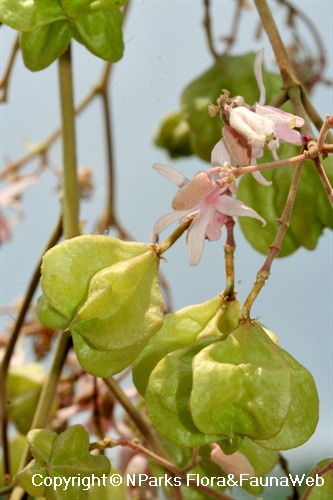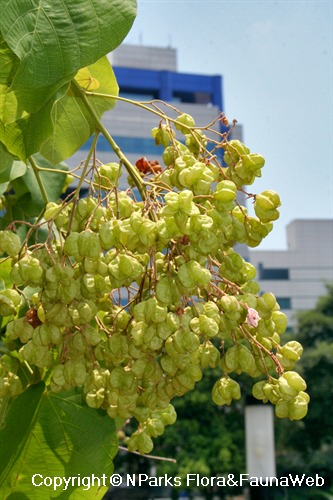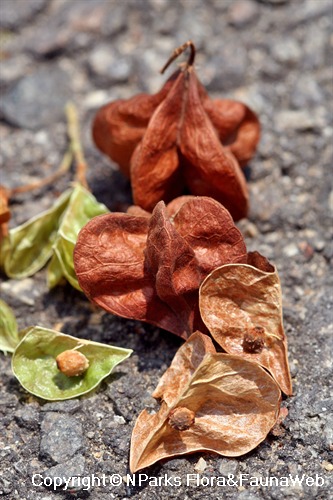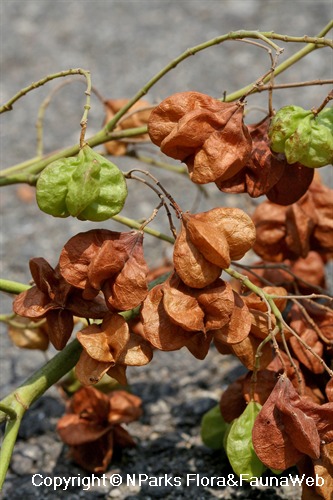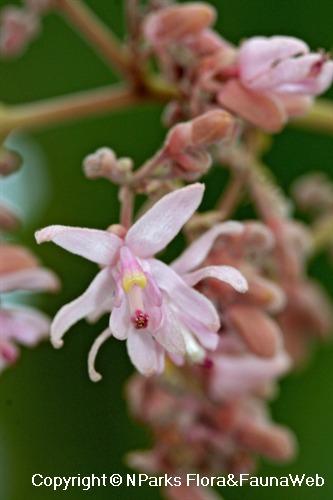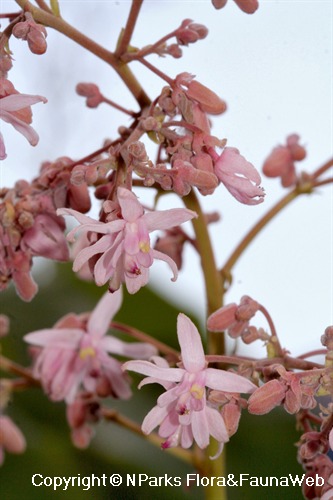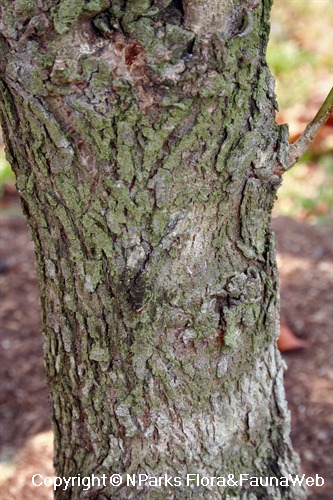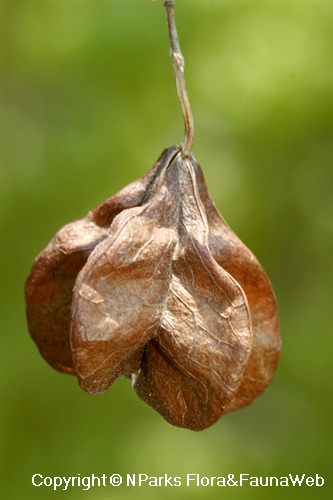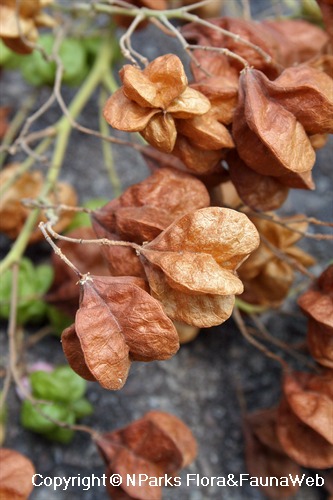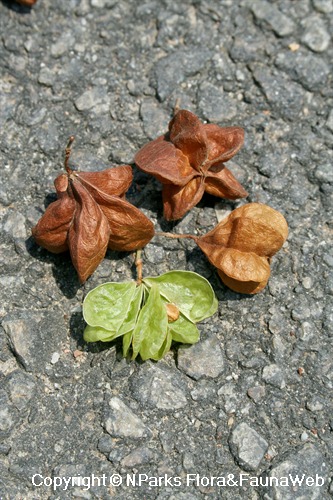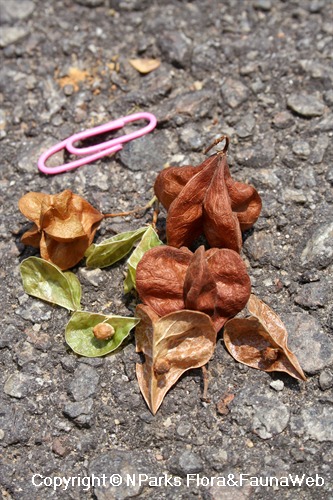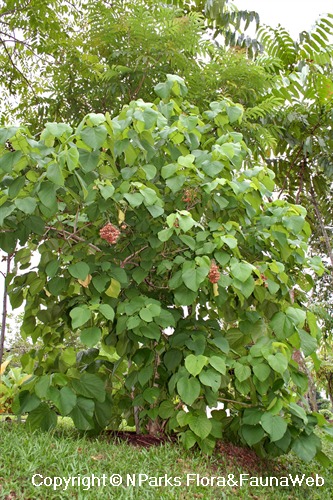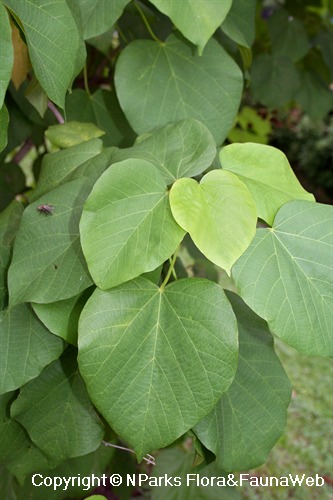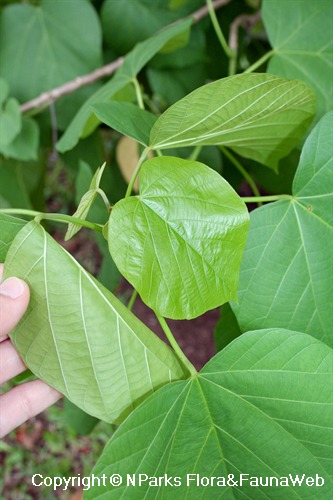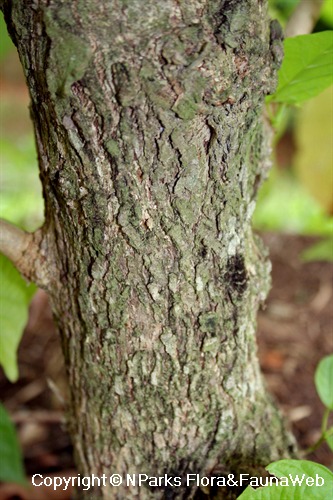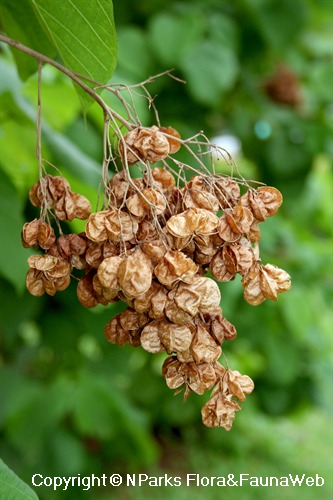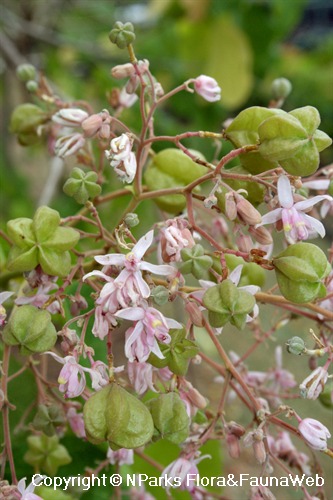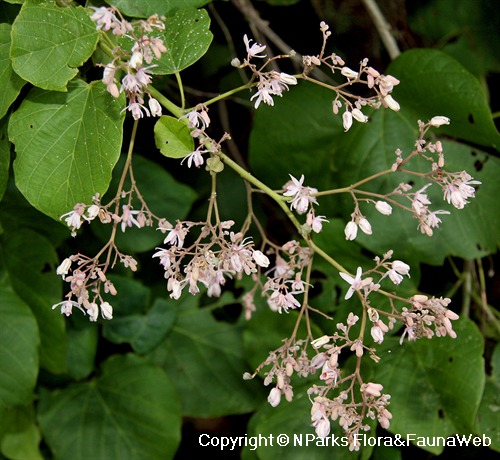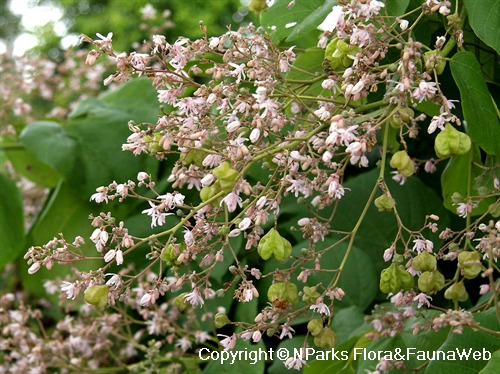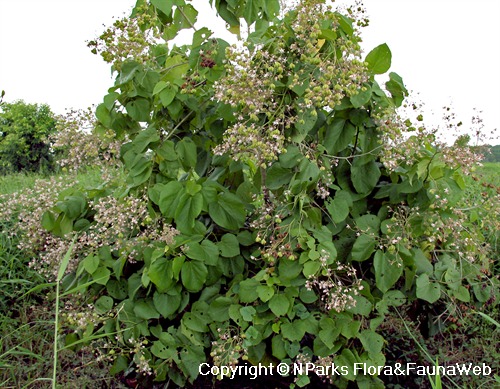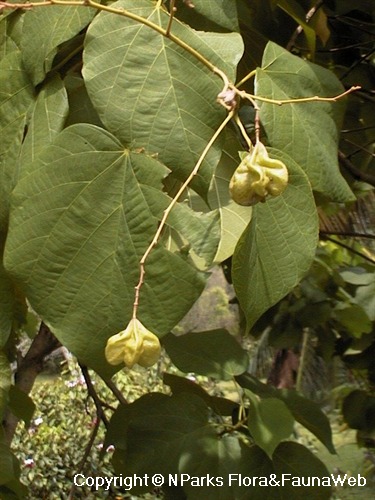
Back
Kleinhovia hospita L.
| Family Name: | Malvaceae |
| Common Name: | Guest Tree, Bataria Teak, Temahai, Laban, Matakara, Tan-ag, 鹧鸪麻, 克蘭树, 面頭果 |
Name
Classifications and Characteristics
| Plant Division | Angiosperms (Flowering Seed Plants) (Dicotyledon) |
|---|---|
| Plant Growth Form | Tree (Medium (16m-30m)) |
| Lifespan (in Singapore) | Perennial |
| Mode of Nutrition | Autotrophic |
| Plant Shape | Rounded |
| Maximum Height | 8 m to 20 m |
Biogeography
| Native Distribution | India, Southern China, Myanmar, Thailand, Philippines, Malaysia, Singapore, Indonesia, Papua New Guinea, Australia (Queensland), Southwestern Pacific (Fiji, French Polynesia) |
|---|---|
| Native Habitat | Terrestrial (Secondary Rainforest, Monsoon Forest, Coastal Forest, Riverine) |
| Preferred Climate Zone | Tropical, Sub-Tropical / Monsoonal |
| Local Conservation Status | Native to Singapore (Presumed Nationally Extinct (NEx)) |
Description and Ethnobotany
| Growth Form | It is a small to medium tree, up to 20 m tall. |
|---|---|
| Crown | It has a dense, rounded crown with low-branching. |
| Trunk | Bole typically short and low-forking, developing many suckers with age. Bark grey and fissured. |
| Foliage | Its spiral, stalked leaves have leaf blades that are egg- or heart-shaped, and are 5-15 by 3.7-12.5 cm. |
| Stems | Young twigs pubescent. |
| Flowers | Its pink flowers are about 10 mm long and grow in upright flowering shoots. |
| Fruit | Its fruits are roundish, 5-lobed, thin-walled, membraneous inflated capsules, 2-2.5 cm across, with each locule ontaining 1-2 small warty seeds. The fruits are produced in large drooping clusters, ripening from translucent light green to brown, dispersed by water. |
| Habitat | It grows in the open country, along riverbanks, and in secondary forests up to 500 m altitude. |
| Associated Fauna | Its flowers are pollinated by insects. It is the preferred local food plant for the moths Euproctis fulvonigra, Imma thyriditis, and Somena scintillans. |
| Cultivation | Likes well-drained soils, grows well at acidic sites. Leaves provide nutrient-rich mulch. Remove basal shoots if plant is being grown as shade tree with clear trunk. Tree produces fruits within third year of planting. Propagate by seeds, as cuttings are reportedly difficult to root due to presence of continuous sclerenchyma band in the pericycle. |
| Etymology | Genus epithet 'Kleinhovia' named after Christiaan Kleynhoff (died 1777), German doctor and botanist with the Dutch East Indies Company. He established at Batavia Indonesia the trading company's first botanic gardens in Asia, and sent plant collections to Linnaeus, who subsequently named the genus after Kleynhoff. Species epithet 'hospita' derived from the Latin term 'hospes' (guest), meaning 'hospitable' or 'friendly', possibly alluding to the tree's frequent association with human riverside settlements. |
| Ethnobotanical Uses | Edible Plant Parts : Edible Leaves Food (Fruit or Vegetable): Young leaves and shoots eaten as vegetable. Medicinal: Leaves and bark contain cyanogenic compounds, used as hairwash to kill ectoparasites like lice. Leaf juice used as eyewash. Leaf decoction used to treat skin diseases like scabies, itch, and dermatis. Preparation obtained from cambium used to treat pneumonia in Solomon Islands and Papua New Guinea. Leaf extracts exhibit antioxidant and anti-tumour properties, and are being investigated as potential treatment against liver cancer. Timber & Products: Straight branches used for house rafters and agricultural stakes, twisted branches used for ornamental carving and making knife handles. Timber used as fuelwood. Bark fibres used to make rough cordage and water-resistant ropes used to tether livestock. Others: Bark used to stun eels. |
Landscaping Features
| Landscaping | It is suitable for planting in roadsides and parks. |
|---|---|
| Desirable Plant Features | Ornamental Flowers, Ornamental Fruits, Ornamental Foliage |
| Landscape Uses | Coastal, General, Riverine, Suitable for Roadsides, Parks & Gardens, Small Gardens |
| Thematic Landscaping | Naturalistic Garden |
| Usage Hazard - Cons | Low Crown / Clearance |
Fauna, Pollination and Dispersal
| Fauna Pollination Dispersal Associated Fauna | Caterpillar Moth Food Plant, Bee-Attracting |
|---|---|
| Pollination Method(s) | Biotic (Fauna) |
| Seed or Spore Dispersal | Abiotic (Water) |
Plant Care and Propagation
| Light Preference | Full Sun |
|---|---|
| Water Preference | Moderate Water |
| Plant Growth Rate | Moderate |
| Rootzone Tolerance | Fertile Loamy Soils, Well-Drained Soils, Saline Soils / Salt Spray, Moist Soils |
| Maintenance Requirements | Moderate |
| Propagation Method | Seed |
Foliar
| Foliage Retention | Evergreen |
|---|---|
| Mature Foliage Colour(s) | Green |
| Mature Foliage Texture(s) | Smooth, Velvety / Furry / Tomentose |
| Foliar Modification | Stipule |
| Foliar Type | Simple / Unifoliate |
| Foliar Arrangement Along Stem | Alternate, Spiral |
| Foliar Attachment to Stem | Petiolate |
| Foliar Shape(s) | Non-Palm Foliage (Cordate) |
| Foliar Venation | Pinnate / Net |
| Foliar Margin | Entire |
| Foliar Apex - Tip | Acute |
| Foliar Base | Cordate |
| Typical Foliar Area | Mesophyll ( 45cm2 - 182.25 cm2 ) |
| Leaf Area Index (LAI) for Green Plot Ratio | 3.0 (Tree - Intermediate Canopy) |
Non - Foliar and Storage
| Trunk Type (Non Palm) | Woody |
|---|---|
| Bark Colour(s) | Grey |
| Mature Bark Texture | Fissured |
| Stem Type & Modification | Woody |
| Root Type | Underground (Tap Root, Fibrous Root) |
Floral (Angiosperm)
| Flower & Plant Sexuality | Bisexual Flowers |
| Flower Colour(s) | Pink |
|---|---|
| Flower Grouping | Cluster / Inflorescence |
| Flower Size - Remarks | 8-10mm across |
| Inflorescence Type | Panicle |
| Flowering Habit | Polycarpic |
Fruit, Seed and Spore
| Mature Fruit Colour(s) | Brown |
|---|---|
| Fruit Classification | Simple Fruit |
| Fruit Type | Dehiscent Dry Fruit , Capsule |
Image Repository
Others
| Master ID | 1688 |
|---|---|
| Species ID | 2981 |
| Flora Disclaimer | The information in this website has been compiled from reliable sources, such as reference works on medicinal plants. It is not a substitute for medical advice or treatment and NParks does not purport to provide any medical advice. Readers should always consult his/her physician before using or consuming a plant for medicinal purposes. |

